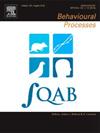焦虑性和焦虑性调节剂对成年斑马鱼在野外适应过程中的趋动性和拍打行为有不同的影响
IF 1.3
4区 生物学
Q4 BEHAVIORAL SCIENCES
引用次数: 0
摘要
开放场测试(OFT)是研究不同焦虑样状态对探索动力学影响的一个有价值的范式。在OFT中,斑马鱼对致焦虑和抗焦虑方案有反应,但这种操作对习惯过程的影响尚不清楚。在这里,我们的目的是阐明不同的焦虑调节剂如何随着时间的推移影响移动性和殴打行为。为此,将成年斑马鱼(Danio rerio)作为焦虑源暴露于吗啡(1.5 mg/L)戒断方案(MOR)和急性同特异性报警物质(CAS) 3.5 mL/L,持续5 min。对于抗焦虑治疗,我们选择急性乙醇(ETOH)浓度为0.5 % (v/v),持续1 h,急性氟西汀(FLU)浓度为100 µg/L,持续15 min。然后,将鱼单独转移到10分钟的OFT试验中,并对行为活动进行后验分析。虽然MOR反应包括多动、更高的移动性和增加的抖动,但CAS表现出更高的完全不动。ETOH暴露减少了外围活动的时间和距离、打闹行为和运动。流感组在周围停留的时间较短,表现出趋动性和搏动性下降。皮尔逊分析有助于阐明终点数据如何相互关联,加强观察到的不同反应。总的来说,我们的研究强调了焦虑性和抗焦虑性方案在趋近性方面所引起的差异效应。此外,我们的研究结果表明,痛打行为是一种有价值的工具,可以改善OFT中的行为分析,有助于进一步深入研究不同的焦虑样状态。本文章由计算机程序翻译,如有差异,请以英文原文为准。
Anxiogenic and anxiolytic modulators differentially affect thigmotaxis and thrashing behavior in adult zebrafish during habituation to the open field test
The Open Field Test (OFT) is a valuable paradigm to study the effects of distinct anxiety-like states on exploratory dynamics. Zebrafish responds to anxiogenic and anxiolytic protocols in the OFT, but the influence of such manipulations on the habituation process is still unclear. Here, we aimed to elucidate how distinct anxiety modulators influence thigmotaxis over time and thrashing behavior. For this, adult zebrafish (Danio rerio) were submitted to the morphine (1.5 mg/L) withdrawal protocol (MOR) and acute conspecific alarm substance (CAS) at 3.5 mL/L for 5 min as anxiogenic exposures. For anxiolytic treatments, we selected acute ethanol (ETOH) at 0.5 % (v/v) for 1 h and acute fluoxetine (FLU) at 100 µg/L for 15 min. Then, fish were individually transferred to a 10-min OFT trial, with posterior analysis of behavioral activity. While MOR responses comprised hyperactivity, higher thigmotaxis, and increased thrashing, CAS showed heightened total immobility. ETOH exposure decreased time spent and distance traveled in the periphery, thrashing behavior, and locomotion. FLU group spent less time in the periphery, showing decreased thigmotaxis and thrashing. Pearson analyses contributed to elucidate how endpoint data correlate to each other, reinforcing the distinct responses observed. Overall, our study reinforces the differential effects evoked by anxiogenic and anxiolytic protocols regarding thigmotaxis. Moreover, our results suggest that thrashing behavior configures a valuable tool to improve behavioral analyses in the OFT, contributing to further in-depth investigations related to distinct anxiety-like states.
求助全文
通过发布文献求助,成功后即可免费获取论文全文。
去求助
来源期刊

Behavioural Processes
生物-动物学
CiteScore
2.70
自引率
7.70%
发文量
144
审稿时长
4-8 weeks
期刊介绍:
Behavioural Processes is dedicated to the publication of high-quality original research on animal behaviour from any theoretical perspective. It welcomes contributions that consider animal behaviour from behavioural analytic, cognitive, ethological, ecological and evolutionary points of view. This list is not intended to be exhaustive, and papers that integrate theory and methodology across disciplines are particularly welcome.
 求助内容:
求助内容: 应助结果提醒方式:
应助结果提醒方式:


